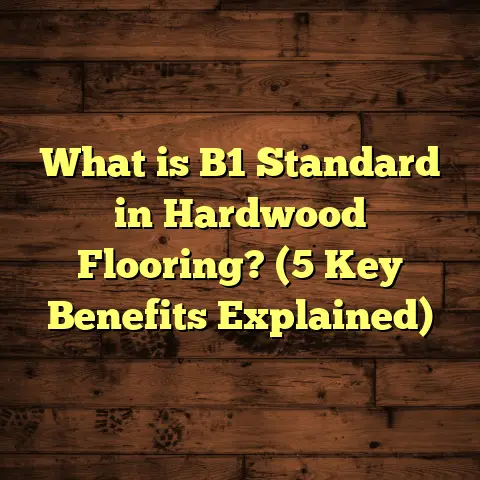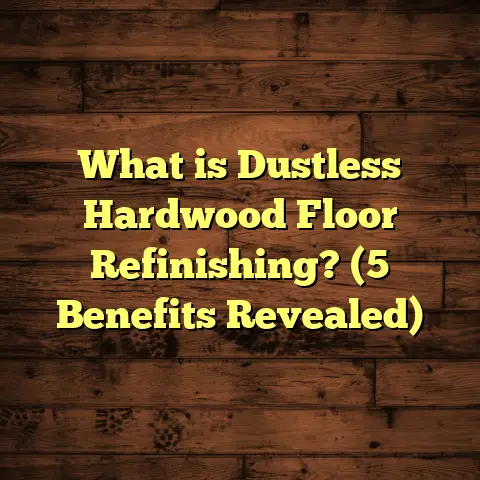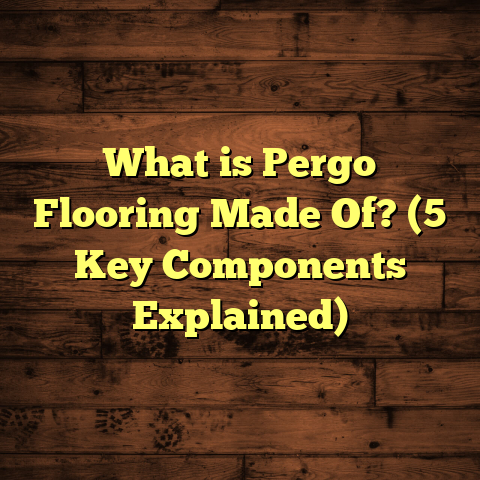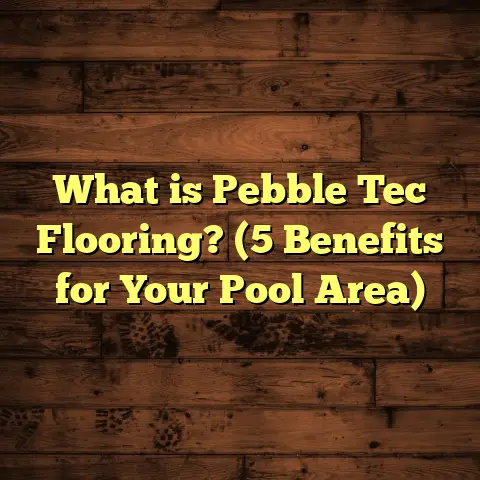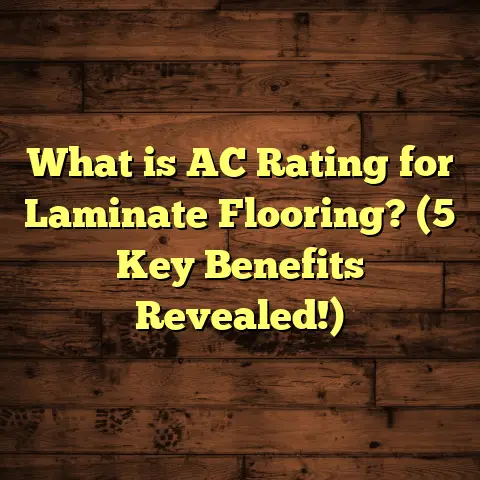What is PVC Wood Flooring? (5 Benefits You Didn’t Know!)
Have you ever stepped into a room and felt an almost instant connection, as if the flooring beneath your feet was welcoming you home? I’ve experienced that moment more than once in my career, and I can tell you—it’s powerful. The right floor can change how a space feels entirely. One kind of flooring I often recommend and install is PVC wood flooring. When I first started mentioning it to clients, many looked puzzled. “What exactly is PVC wood flooring?” they asked. Today, I want to share everything about it—the good, the little-known perks, and the reasons why it might be perfect for your home.
What Is PVC Wood Flooring?
Let’s start with the basics: What is PVC wood flooring?
PVC wood flooring is a type of synthetic floor designed to look and feel like traditional hardwood but made with polyvinyl chloride (PVC) as the core material. Unlike natural wood floors that come from trees and require careful maintenance, PVC wood flooring is manufactured using plastic polymers combined with high-quality printed layers that replicate wood grain textures and colors.
The result is a floor that visually mimics hardwood but offers different physical properties—most notably enhanced resistance to water, scratches, and dents.
Breaking Down the Composition
To understand why PVC wood flooring performs so well, it helps to know its layers:
- Wear Layer: This topmost layer protects the floor from scratches, stains, and fading. It’s usually transparent but tough.
- Decorative Layer: A high-resolution printed image layer that recreates the look of real wood—knots, grain patterns, even subtle color variations.
- Core Layer: Made mostly of PVC. This provides the floor with flexibility, water resistance, and impact absorption.
- Backing Layer: Stabilizes the plank or tile and prevents moisture from seeping up from below.
When these layers are combined using advanced manufacturing techniques, you get a flooring product that looks authentic but lasts much longer in everyday environments.
PVC Wood Flooring vs. Other Flooring Types
You might be wondering how this compares to other popular options:
- Natural Hardwood: Beautiful and classic but vulnerable to moisture and scratches.
- Engineered Wood: Real wood veneer over plywood layers; more stable than hardwood but still sensitive to water.
- Laminate Flooring: Melamine-topped fiberboard with printed wood images; affordable but less water-resistant.
- Vinyl Flooring: Fully synthetic, waterproof, but sometimes less realistic-looking.
- PVC Wood Flooring: Combines vinyl’s durability with enhanced visual realism and comfort.
In my experience working with all these materials over years, PVC wood flooring offers a sweet spot for homeowners wanting style without sacrifice.
My Journey With PVC Wood Flooring
I remember my first real encounter with PVC wood flooring vividly. It was a project in a coastal home where traditional hardwood had been destroyed by saltwater intrusion and humidity. The homeowners loved the warmth of wood but needed something that could handle their environment.
After installing PVC wood floors with a grain texture mimicking aged oak, the transformation was immediate. Not only did the floors look stunning, but the owners called me months later to say they’d never worry about water damage again. That experience pushed me to learn more about this material—and I’ve never looked back.
Every client since has benefited from what PVC wood flooring offers—whether it’s in wet rooms like bathrooms or busy kitchens or in family rooms that see heavy foot traffic.
Five Benefits of PVC Wood Flooring You Probably Didn’t Know
Now that you know what PVC wood flooring is, let me share five benefits that often surprise people when they learn about them.
1. Water Resistance That Protects Your Floor and Wallet
One of the most impressive features of PVC wood flooring is its water resistance. If you have kids or pets—or if your home has basements or bathrooms—you know water spills are inevitable.
Traditional hardwood floors are susceptible to moisture:
- They can swell.
- They may warp.
- Nailing patterns loosen.
- They require expensive repairs or refinishing.
According to data from the National Wood Flooring Association (NWFA), moisture-related damage accounts for nearly 20% of all hardwood floor failures nationwide. That’s a significant risk!
PVC wood flooring eliminates this issue because its core layer is made from waterproof PVC plastic. It will not absorb water or swell. Even if water sits on its surface for hours, it won’t harm the floor. This makes it ideal for kitchens, mudrooms, laundry rooms, and even bathrooms where moisture is common.
I once installed PVC wood flooring in a family kitchen where the owners had previously replaced hardwood twice due to spills and leaks. After two years with PVC floors, they told me they felt completely stress-free about everyday messes.
2. Installation Is Simpler Than You Think
If you’ve ever watched hardwood installation or had it done yourself, you know it can be disruptive and time-consuming. Hardwood requires acclimation days before installation, precise cutting, nailing or gluing, sanding, finishing—the works.
PVC wood flooring usually comes with a click-lock system—planks snap together easily without nails or glue. This means:
- Faster installation times.
- Less mess and noise.
- Lower labor costs (or easier DIY projects).
- No need for acclimation to room humidity.
Installing this type of floor typically takes 30-50% less time than hardwood or engineered wood floors. That saves money if you hire professionals and gets your home back to normal faster.
I helped a friend install PVC wood flooring in their spare room over a weekend. They were amazed at how fast it went down and how professional it looked afterward.
3. Comfort When Walking and Noise Reduction
Here’s something that often surprises people: unlike hardwood or laminate, PVC wood flooring feels softer underfoot because of its flexible core. It absorbs impact better, which makes standing or walking on it more comfortable over long periods.
If you’re like me and spend hours on your feet cooking or cleaning, this can reduce fatigue significantly.
Noise reduction is another benefit I’ve seen firsthand. Hard surfaces amplify footsteps and dropped objects; PVC wood flooring reduces noise transmission because the plastic core absorbs sound vibrations better.
This makes a big difference in multi-story homes or apartments where noise complaints can be an issue.
One condo client told me their upstairs neighbors noticed fewer noise disturbances after installing PVC wood flooring below.
4. Maintenance Is a Breeze
Who wants to spend hours cleaning floors every week? With PVC wood flooring, maintenance is almost effortless:
- Spills wipe up instantly without staining.
- Regular sweeping and occasional damp mopping keep it looking fresh.
- No waxing or refinishing required.
- Resistant to scratches and dents from furniture or pet claws.
In contrast, hardwood floors require careful cleaning products and refinishing every few years. Laminate floors can’t tolerate standing water and can swell.
For busy families or pet owners, this ease of care translates into real peace of mind—and time saved for more enjoyable things in life.
I’ve seen homes where pets have scratched floors heavily over years with no visible damage on the PVC wood floors underneath.
5. Growing Environmental Benefits
When synthetic floors first came out decades ago, many people worried about their environmental impact—the production processes and plastic waste concerns were valid.
Today though, many manufacturers produce eco-friendly PVC wood flooring lines:
- Using recycled PVC materials.
- Low-emission production processes.
- Floors certified by environmental standards such as FloorScore or GREENGUARD.
- Floors are recyclable at end-of-life in some areas.
Recent market research shows sustainable flooring demand growing at around 12% annually worldwide as consumers become more eco-conscious.
I work closely with suppliers who prioritize low-VOC (volatile organic compound) emissions and use recycled content in their products—allowing environmentally aware homeowners to enjoy durable floors without guilt.
Digging Deeper: Data & Case Studies
To bring these benefits into sharper focus, here are some key data points and real-world examples I gathered during my years working as a flooring contractor:
| Aspect | Traditional Hardwood | Laminate | Vinyl | PVC Wood Flooring |
|---|---|---|---|---|
| Water Resistance | Low | Moderate | High | Very High |
| Installation Time | Long (3+ days) | Moderate | Short | Very Short (1 day typical) |
| Scratch Resistance | Moderate | High | Moderate | High |
| Comfort Underfoot | Hard | Hard | Soft | Softer |
| Maintenance Ease | Moderate | Easy | Easy | Very Easy |
| Environmental Impact | Renewable but resource-heavy | Low | Medium | Improving with recycled materials |
Case Study #1: Coastal Home Renovation
A couple living near the ocean faced ongoing issues with hardwood floors warping due to humidity and salt air exposure. They wanted the look of weathered oak but something more resilient.
We installed textured PVC wood planks with an extra thick wear layer designed for high traffic areas. Six months later:
- No signs of warping or discoloration.
- Easy cleanup after beach visits.
- Compliments on how natural it looks from guests.
Case Study #2: Busy Family Kitchen
A family of four with two young kids had hardwood floors showing scratches and stains from daily spills. They chose PVC wood flooring for their kitchen remodel.
After one year:
- No visible scratches despite heavy use.
- Water spilled during cooking wiped up immediately.
- Kids love walking barefoot on softer surface than before.
Case Study #3: Apartment Noise Solutions
An apartment building manager wanted to reduce noise complaints between units caused by hard footsteps on laminate floors.
We installed PVC wood flooring in several units because of its sound absorption qualities.
Residents reported:
- Quieter living environment.
- Improved satisfaction with flooring comfort.
What About Cost?
Cost is always a factor when choosing flooring materials. Here’s what I’ve found through experience and research:
| Flooring Type | Average Cost per sq.ft (Material + Installation) |
|---|---|
| Hardwood | $8 – $15 |
| Engineered Wood | $6 – $12 |
| Laminate | $3 – $8 |
| Vinyl | $2 – $7 |
| PVC Wood Flooring | $4 – $9 |
PVC wood flooring typically falls into a mid-range price bracket—not as cheap as basic vinyl but considerably less expensive than premium hardwoods. Installation savings due to faster setup also help keep total project costs manageable.
Using tools like FloorTally can help get precise estimates based on your local market conditions and specific preferences—saving you from sticker shock later on.
Design Flexibility You’ll Love
One thing I enjoy about PVC wood flooring is the design freedom it offers homeowners:
- Wide range of wood species visuals—from rustic pine to dark walnut.
- Different plank widths and lengths for custom looks.
- Textured finishes for more authentic touch.
- Matte or glossy sheens depending on style preference.
- Ability to mix with other materials in open-plan spaces.
Because these floors are printed using high-definition technology, patterns are incredibly detailed—sometimes indistinguishable from real wood at casual glance.
What Should You Look for When Choosing PVC Wood Flooring?
If you’re interested in trying this type of floor, here are some tips I give clients during consultations:
- Wear Layer Thickness: A thicker wear layer means greater durability—look for at least 0.3 mm for residential use.
- Core Density: Higher density cores resist dents better.
- Waterproof Certification: Confirm if the product is 100% waterproof (some cheaper versions may not be).
- Warranty: Good manufacturers offer warranties ranging from 10 to 25 years.
- Eco-Certifications: If sustainability matters to you, check for FloorScore or GREENGUARD labels.
- Installation Method: Choose click-lock systems for easiest DIY installation; glue-down versions exist too.
- Samples: Always order samples to see colors and feel texture before buying hundreds of square feet.
Common Questions I Get About PVC Wood Flooring
Q: Can I install PVC wood flooring over existing floors?
A: Yes! One highlight is its versatility—it can often be installed directly over tile, vinyl, or even concrete slabs after proper preparation.
Q: How does it hold up against pets?
A: Very well! Its scratch resistance combined with easy cleaning makes it pet-friendly. I’ve installed it in many homes with dogs that shed claws regularly.
Q: Does it fade in sunlight?
A: High-quality options have UV-resistant coatings preventing fading even in sunlit rooms.
Q: Is it cold in winter?
A: It does feel cooler than carpet but warmer than tile due to its plastic core’s slight insulation properties. Adding area rugs helps too!
Final Thoughts—Why I Recommend PVC Wood Flooring
After dozens of installations across different environments—humid coastal homes, hectic family kitchens,
and quiet condos—I’ve seen firsthand how PVC wood flooring solves problems others cannot:
- No water damage worries.
- Faster installation saves time/money.
- Comfortable walking surface.
- Noise reduction benefits.
- Easier maintenance without losing style.
- Increasingly green manufacturing options.
If you want a floor that looks great today—and stays great tomorrow—PVC wood flooring deserves serious consideration.
So what do you think? Does this sound like the right fit for your home? If you want help figuring out styles or budgeting your project accurately,
tools like FloorTally can provide local price estimates instantly based on your choices—giving you confidence before making decisions.
Feel free to ask anything else! Flooring has been my passion for years,
and sharing what works best is something I enjoy deeply.

